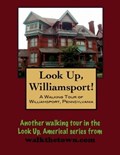There is no better way to see America than on foot. And there is no better way to appreciate what you are looking at than with a walking tour. Whether you are preparing for a road trip or just out to look at your own town in a new way, a downloadable walking tour is ready to explore when you are.
Each walking tour describes historical and architectural landmarks and provides pictures to help out when those pesky street addresses are missing. Every tour also includes a quick primer on identifying architectural styles seen on American streets.
Williamsport for decades was an unremarkable crossroads community of less than 2,000 people, a stop along the Pennsylvania Canal and a marketing destination for the numerous small farms of the area. In 1847, the potential for the logging business took a great leap forward with the establishment of the first “Log Boom” in the Susquehanna River. The west branch of the river from Linden to Halls Station was referred to as the “Long Reach,” which was an area of almost no fall in the elevation of the riverbed. This provided an ideal point to locate a log boom, which was a series of river piers with heavy chains strung between them used to catch the slow moving logs as they came down the river. This fostered the development of an entire series of related lumber processing sites in Williamsport that included log cribs and ponds, sawmills, storage and rail yards.
The impact on the town was dynamic; between 1860 and 1870, six major railroad lines arrived and the population tripled. By 1886, there were 28,000 inhabitants of the city. Williamsport, with 29 sawmills, became known as the lumber capital of the world. Its great mills, strategically located on the Susquehanna River, were supplied by the log boom that stretched seven miles along the river front and was credited with a holding capacity of over 250 million board feet of lumber or nearly two million logs.
It was on this wooden foundation that fortunes were made. Williamsport was said to have had more millionaires than any place in America for a time. The lumber barons built spectacular homes, first along East Third Street and then migrating to West Fourth Street, which remained a fashionable neighborhood well into the 1900s before numerous demolitions and commercial development nearly erased all vestiges of its one-time splendor.
In 1889, the Susquehanna River swelled over its banks and caused considerable damage to the lumber facilities located in the city. This, coupled with the declining timber resources, signaled an end to the traditional economic base, although the lumber business remained until the early 1900s.
Our walking tour will begin just east of Millionaires Row, as West Fourth Street came to be know, and explore the downtown area before reversing course and seeing what traces remain of some of Pennsylvania's greatest fortunes...

